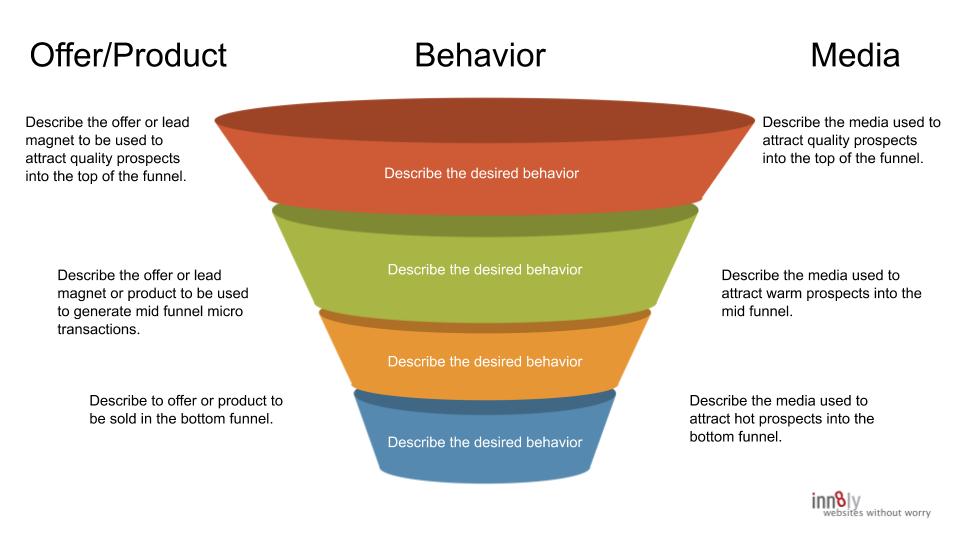Funnels in Marketing – A Practical Model for Small Businesses
In an earlier post, Combine Traffic, Trust, and Value for Effective Marketing Funnels, we explained why the marketing funnel works. In this post, we show you how to use funnels in marketing and provide some practical use cases and examples. You can use these ideas to implement digital marketing funnels for your small business marketing.
The Marketing Funnel Explained
The image below is a model that we use with our customers. It presents the three areas: the Offer or Product, the Behavior you plan to elicit, and the Media you will use to reach your audience and stimulate the desired behavior at each layer of the marketing funnel. Our customers find this one-page plan useful when they are developing their digital marketing plan.


You can access the Google Slides and use them for your business.
Use the button to sign up for our newsletter, and we will send you the link to download a copy of the Marketing Funnel Plan Template.
Non-Icky Marketing Funnels Support the Buyer’s Journey.

A marketing funnel has three broad areas:
- The top of the funnel is where you attract high-quality traffic,
- The middle of the funnel is where you want to build trust through microtransactions of ever-increasing value and
- The lower funnel is where a decision is made, and mutual value is created.
Top of Funnel – Awareness and Attraction

Your plan should map out the products/offers, behavior, and media you will use for each layer. For example, a common top-of-funnel asset would be a blog post with content that appeals to your target prospect. You could use paid ads on Social Media (Facebook and Instagram) or organic social media activity that promotes the content. The traffic to your website and/or engagement with your social media posts starts their journey. It also feeds the Facebook pixel so you can retarget this audience with mid-funnel products and offers.
Mid Funnel – Consideration and Relationship

Mid-funnel activity is designed to build trust. The mid-funnel area has two parts: upper-mid and lower-mid funnel, reflecting its importance to marketing funnel effectiveness. Mid-funnel tactics and offers could be lead magnets, video views, or infographics—anything where the perceived value exceeds the cost of the interaction.
For example, upper mid-funnel behavior could be a post ‘like,’ a comment, or watching a video. Lower mid-funnel behavior is more involved. For example, it could be an eBook given to prospects who join the email list or an assessment survey. No money has changed hands, but these low-cost microtransactions build trust. The media used would include targeted social media ads. The cost per thousand for this type of media is higher, but the audience is narrower, so the investment is reasonable.
As prospects self-identify and communicate their interest, the incentives and microtransaction value increase. Giving up an email address for an eBook is a richer transaction than liking a Facebook post or following a page.
Lower Funnel – Prospecting and Conversion

The lower funnel activities focus on conversion and the products you’ve designated as entry point products. They aren’t usually your high-priced products. You can upsell to them using a sales funnel or as part of an ongoing customer communication plan. These are products at a price point where the exchange of value isn’t huge but it is meaningful. These prospects are now customers.
Offer/Product
Relevant content is the easiest and, in many ways, most effective traffic-driving offer. Listen to your customers. Hear what they are saying about your products or services. What problems are you solving for them? For example, review the comments made on your ads and your competitors’ ads. These comments are content ideas gold. Create content (blog or social media posts) that speaks to their concerns.
Content and Funnels in Marketing
The content you create will appeal to your existing customers, increasing the value they receive from your business and making them more loyal. If the content appeals to your current customers, then it will appeal to prospects just like your existing customers. What could be better than attracting more best customers?
You can use content to attract customers via organic searches. Writing blog posts that rank is an excellent long-term strategy. You can repurpose the same content using the Facebook ad manager to boost your posts. Boosting because Facebook says it’s a good idea is generally a bad idea. Boosting posts when you are doing it to generate top-of-funnel traffic is a great idea. When it’s part of a plan, it’s an excellent way to have prospects self-identify and enter your funnel.
See how funnels in marketing attract qualified prospects, build trust through microtransactions, and convert prospects into customers. Share on XFree webinars are another excellent top-of-funnel offer. The content serves as an attraction device, and you capture their email when they register. Email marketing is an efficient way to market these folks. You also capture them with the Facebook pixel, which allows you to target them with offer ads.
You can post an edited (shorter) version of the webinar on Facebook and Instagram. The Facebook pixel will track people who view the video. You can use this to create a custom audience from the people who watched 75% or more of the video. This is a very warm audience. You can then create a lookalike audience using the 75% view-through audience.

You can also post edited versions of the webinar to YouTube, the second most important search engine. Invite viewers to learn more on your website.
You can have the webinar transcribed, edited, and then use the transcription to create a series of blogs or Facebook posts. Use edited bits from the video to create ads that you use to boost the posts.
Some people are visual learners. A slide deck that shows them how to do something or solve a problem can be an effective top-of-funnel traffic driver. Craft the slide deck from the script you created for the webinar. You might post a short version of the slide deck on a presentation-sharing platform like SlideShare and invite readers to learn more by following a link to your website. You can also convert the slides into video ads or carousel ads for Facebook, Instagram, and LinkedIn.

Pinterest is another platform that can efficiently attract your ideal audience. Like YouTube, Pinterest is also a search engine, and it is the only social media platform that rewards link clicks. We find it useful for driving traffic to blog posts like this.
Free things are always useful, especially when they are relevant to the best customers. You can also use checklists and tip sheets, infographics, guides, and eBooks to attract prospects to your funnel.

The quiz funnel is another top-of-funnel offer that you can use. They are especially useful on Facebook and Instagram. Social Media ads are interruption ads. People are on the platforms because they want to be. They are there for the content offered by the platform. A quiz can be completed within the ad and is especially appealing when it’s entertaining and relevant to their interests. Facebook Poll ads allow you to do this.
There are many possible choices you can use to attract prospects when you use funnels in marketing. Always consider the balance between attractiveness and effectiveness. A low-cost offer that attracts many prospects of low value may make sense. Equally, a richer offer that attracts high-quality prospects can also make sense. With the former, you will need to use the funnel to weed out the low-quality responders. With the latter, you run the risk of limiting the number of prospects that enter your funnel. Neither is a right or wrong choice.
Behavior
It is rare for any B2C or B2B consumer to impulse purchase online. It’s not impossible, but don’t count on it. The marketing funnel aims to identify, grow, and then sell qualified prospects. A small business marketer wants to do this efficiently. Planning for and being deliberate about the behavior encouraged within the funnel is vital to this. Each interaction and each microtransaction builds trust and warms prospects.
As you consider the behavior you want to encourage, you also want to consider where your prospects are in their journey. Make it easy for them to engage! Draw them in. Look for the simple things prospects can do, microtransactions, that increase trust and communicate that they are interested in your product. Every interaction and every behavior can be an opportunity to build a relationship with your audience. Retargeting these people is efficient and effective once they’ve interacted with your marketing. You know who they are, and even more importantly, they know who you are.
Examples of microtransactions:
- Follow a link to read a post
- Like a post or follow social media page
- Comment on a post
- Share a post
- Watch a video
- Respond to a poll or survey
- Subscribe to a channel (YouTube)
- Join a newsletter list
- Download a lead magnet
- Purchase a lead magnet
Managing and tracking behavior is key to a successful marketing funnel. Choose carefully, test your decisions, water the flowers, and prune the weeds. Attract the right people for the right reasons.
Media
You can use many media choices throughout the funnel. What matters is how you use the media.
Top-of-Funnel Media
Organic social media, like adding posts to your Facebook page and images to Instagram, is inexpensive and shouldn’t be ignored, but your reach will be limited. It depends in large part on how many people are following your page, and even then, the social media platforms limit the number of people who see your posts.
Generally, you are better off using social media ads to get your content in front of prospects. Social media ads aren’t expensive, and the traffic you generate tells the pixel “who” is interested in your offer.
You can learn more about top-of-funnel marketing in our post, Top-of-Funnel Marketing Secrets Revealed.
Mid-Funnel Media
You will continue to use social media ads for mid-funnel media. The difference will be the ad messaging, what your ads say, and more refined targeting. Email marketing will also start to be involved. Capturing email addresses using email automation to drip content to prospects is highly efficient. Google Adwords will also be a factor.
Mid-funnel tactics are often overlooked, which is a mistake. The mid-funnel is where you have your best opportunity to build a relationship with your customers. Mid-funnel tactics are so important that we wrote about them here: Mid-Funnel Marketing: 3 Tactics Every Marketer Should Use.
Lower-Funnel Media
Social media ads using strong conversion language and precise targeting, email marketing, and Google Adwords are the three horsemen of lower-funnel media.
Manage these efforts carefully. Understanding your Allowable Cost per Order, link tracking, and constant testing are vital. You can learn more about the Lower funnel here: Lower Funnel Marketing Demystified.
But what about…
You can, and often should, consider other media channels. LinkedIn, for example, can be effective, especially for B2B campaigns. In this post, we’ve focused on the most common channels. Whatever you choose, be sure to target the right people and use the right message or offer. Test, test, and then test some more.

Water the flowers and prune
the weeds
Conclusion – Funnels in Marketing Explained
A non-icky marketing funnel draws in qualified prospects, builds trust through microtransactions, and then converts prospects into customers as part of their journey.
Each layer in the funnel (top-funnel, mid-funnel, and lower-funnel) has its unique application based on three factors: the product or offer, the behavior, and the media used.
At all levels, testing your decisions will lead to more efficient marketing.
Marketing funnels may sound like a lot of effort, and they are. You need to do the work or hire a qualified expert to execute the plan, but the results can be highly lucrative. ROIs of 1,000% and more are not uncommon, but you won’t get there immediately. Did I mention that you need to do the work? Results like this are achievable.
We have a lot of experience with this and would be happy to help. We designed Inn8ly website software to facilitate digital marketing.
Profitable Google Ads – 7 Steps to a Revenue Faucet
Learn how profitable Google Ads Search campaigns are possible and likely if marketers are patient and make data-driven adjustments.
Want to Increase Marketing Effectiveness?
Maximize marketing ROI with performance tracking.
Unlock the Power of Email Marketing for Your Business
This power and importance of email marketing to your business success.
Author: James Hipkin
Since 2010, James Hipkin has built his clients’ businesses with digital marketing. Today, James is passionate about websites and helping the rest of us understand online marketing. His customers value his jargon-free, common-sense approach. “James explains the ins and outs of digital marketing in ways that make sense.”
Use this link to book a meeting time with James.
